Qualcomm Technologies focuses on building autonomous driving (AD) technologies that can cover the entire spectrum of autonomy and span from premium solutions to mass-market offerings.
Autonomous vehicles rely on three main technologies, the first of which is high-precision localization, robust and reliable environment perception and last but not least the prediction and motion planning algorithms for safe manoeuvres. The motion planner is easier to achieve as long as the accuracy of the localization and perception data is higher.

Photo Credits: Qualcomm
- The unified localization solution
An autonomous vehicle must be able to localize itself within a few centimetres of accuracy to plan and execute complex manoeuvres required in real-world road conditions. A way to reach higher levels of accuracy is by HD Maps. Qualcomm shared:
“Our approach is to develop advanced and optimized modules that solve such challenges for our automotive OEM customers and partners.”
One such component is Qualcomm Vision Enhanced Precise Positioning (VEPP) software, which can provide lane-level positioning and a precise heading in the global coordinates by tightly fusing GNSS, IMU, camera, and vehicle odometry information in real-time and in virtually all environments.
The localization solution fuses the global pose with camera perception and HD map information and also provides an ability to generate a local map, by producing identification of gaps or errors in HD maps on the fly — all while the vehicle can operate in an autonomous mode.
- Novel techniques for efficient environment perception
One of the main focus areas for Qualcomm is to scale environmental perception technologies in a more efficient way. Their aim is to harness all sensor types including cameras, radar, and lidar, as well as maps to build novel ways of solving environment perception challenges.
There is multisensor data fusion, which includes data association, as well as object-state estimation. Data association is basically the ability of the autonomous vehicle to correlate data from different views. State estimation involves tracking real-world objects and estimates their size, speed, and position relative to the autonomous vehicle itself.
Another Qualcomm’s focus area is the accurate prediction of the pose and tracking the size of objects on the road with 3D estimations. This happens by the use of 2D data from cameras, radar and maps. 3D estimations leveraging both deep learning and concepts from multi-view geometry. Such accurate 3D estimations can enable human-like manoeuvres for the advanced safety of the autonomous vehicle.
- Accelerating autonomous driving solutions
Qualcomm Technologies has been at the forefront of providing connectivity solutions. Building on this solid understanding of the automotive industry, the representatives of Qualcomm are now helping drive some of the biggest innovations in AD.
Their comprehensive frameworks and tools around cross-sensory calibration, active learning, big data management, and automated verification/validation can significantly reduce the time-to-market for autonomous vehicle manufacturers.








